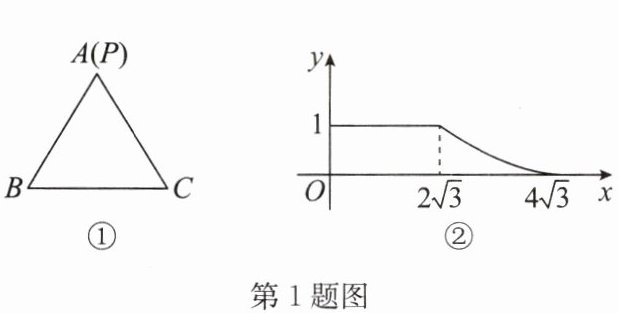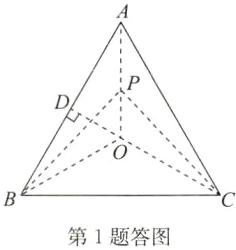1. 如图①,点 $P$ 从等边三角形 $ABC$ 的顶点 $A$ 出发,沿直线运动到三角形内部一点,再从该点沿直线运动到顶点 $B$。设点 $P$ 运动的路程为 $x$,$\frac{PB}{PC}= y$,图②是点 $P$ 运动时 $y$ 随 $x$ 变化的关系图象,则等边三角形 $ABC$ 的边长为( )

A.$6$
B.$3$
C.$4\sqrt{3}$
D.$2\sqrt{3}$

A.$6$
B.$3$
C.$4\sqrt{3}$
D.$2\sqrt{3}$
答案:
1. A 点拨:如答图,令点P从顶点A出发,沿直线运动到三角形内部一点O,再从点O沿直线运动到顶点B。
结合题图可知,当点P在AO上运动时,$\frac{PB}{PC}=1$,
$\therefore PB=PC$,$AO=2\sqrt{3}$。
又$\because \triangle ABC$为等边三角形,$\therefore \angle BAC = 60^{\circ}$,$AB = AC$。
又$\because AP = AP$,$\therefore \triangle APB\cong \triangle APC(SSS)$,
$\therefore \angle BAO = \angle CAO = 30^{\circ}$。
当点P在OB上运动时,可知点P到达点B时,点P运动的路程为$4\sqrt{3}$,
$\therefore OB = 4\sqrt{3}-2\sqrt{3}=2\sqrt{3}$,即$AO = OB = 2\sqrt{3}$,
$\therefore \angle BAO = \angle ABO = 30^{\circ}$。
如答图,过点O作$OD\perp AB$,垂足为D,
$\therefore AD = BD$,则由勾股定理得$AD = 3$,
$\therefore AB = AD + BD = 6$,
即等边三角形ABC的边长为6。故选A。
1. A 点拨:如答图,令点P从顶点A出发,沿直线运动到三角形内部一点O,再从点O沿直线运动到顶点B。

结合题图可知,当点P在AO上运动时,$\frac{PB}{PC}=1$,
$\therefore PB=PC$,$AO=2\sqrt{3}$。
又$\because \triangle ABC$为等边三角形,$\therefore \angle BAC = 60^{\circ}$,$AB = AC$。
又$\because AP = AP$,$\therefore \triangle APB\cong \triangle APC(SSS)$,
$\therefore \angle BAO = \angle CAO = 30^{\circ}$。
当点P在OB上运动时,可知点P到达点B时,点P运动的路程为$4\sqrt{3}$,
$\therefore OB = 4\sqrt{3}-2\sqrt{3}=2\sqrt{3}$,即$AO = OB = 2\sqrt{3}$,
$\therefore \angle BAO = \angle ABO = 30^{\circ}$。
如答图,过点O作$OD\perp AB$,垂足为D,
$\therefore AD = BD$,则由勾股定理得$AD = 3$,
$\therefore AB = AD + BD = 6$,
即等边三角形ABC的边长为6。故选A。
2. 如图①,在长方形 $ABCD$ 中,动点 $P$ 从点 $B$ 出发,沿 $BC$,$CD$,$DA$ 运动至点 $A$ 停止,设点 $P$ 运动的路程为 $x$,$\triangle ABP$ 的面积为 $y$,$y$ 关于 $x$ 的函数图象如图②。若 $b - 2a = 5$,则长方形 $ABCD$ 的周长为

18
。
答案:2. 18 点拨:结合题图可知$BC = a$,$\frac{1}{2}AB\cdot BC = 10$,
$\therefore AB=\frac{20}{a}$,$\therefore BC + CD + DA = b = 2a+\frac{20}{a}$。
$\therefore b - 2a=\frac{20}{a}$。又$\because b - 2a = 5$,$\therefore \frac{20}{a}=5$,$\therefore a = 4$。
$\therefore AB = 5$,$BC = 4$。
$\therefore$长方形ABCD的周长为$2×(5 + 4)=18$。
$\therefore AB=\frac{20}{a}$,$\therefore BC + CD + DA = b = 2a+\frac{20}{a}$。
$\therefore b - 2a=\frac{20}{a}$。又$\because b - 2a = 5$,$\therefore \frac{20}{a}=5$,$\therefore a = 4$。
$\therefore AB = 5$,$BC = 4$。
$\therefore$长方形ABCD的周长为$2×(5 + 4)=18$。
3. 如图①,一条笔直的公路上有 $A$,$B$,$C$ 三地,甲、乙两辆汽车分别从 $A$,$B$ 两地同时开出,沿公路匀速相向而行,驶往 $B$,$A$ 两地。甲、乙两车与 $C$ 地的距离 $y_{1}$,$y_{2}$($km$)与行驶时间 $x$($h$)的部分关系图象如图②,回答下列问题:
(1) $A$,$B$ 两地间的距离为
(2) 图②中,$M$ 点对应的时间是
(3) 甲、乙两车行驶多长时间时,两车到 $C$ 地的距离相等?

(1) $A$,$B$ 两地间的距离为
150
$km$;(2) 图②中,$M$ 点对应的时间是
1.2
$h$;(3) 甲、乙两车行驶多长时间时,两车到 $C$ 地的距离相等?

答案:3.
(1)150
(2)1.2 点拨:$\because$甲、乙两车匀速行驶,$AC = 60$km,$BC = 90$km,
$\therefore$甲车的速度为$60÷1 = 60$km/h,乙车的速度为$(60 + 90)÷2 = 75$km/h,
$\therefore$乙车到达C地的时间为$90÷75 = 1.2$h,
$\therefore$点M对应的时间是$1.2$h。
(3)解:分情况讨论:
①当甲车经过C地,乙车还未到C地且甲、乙相遇时,此时两车与C地的距离相等,
此时两车行驶的时间为$150÷(60 + 75)=\frac{10}{9}$h。
②当甲、乙两车都经过C地时,甲车距离C地的路程等于乙车距离C地的路程,
设此时两车行驶的时间为$x$h,则$75x - 90 = 60x - 60$,解得$x = 2$。
③当甲、乙两车都未到C地时,甲车距离C地的路程等于乙车距离C地的路程,设此时两车行驶的时间为$y$h,则$90 - 75y = 60y - 60$,解得$y = 2$,不合题意,舍去。
综上,两车行驶$\frac{10}{9}$h或$2$h,两车到C地的距离相等。
(1)150
(2)1.2 点拨:$\because$甲、乙两车匀速行驶,$AC = 60$km,$BC = 90$km,
$\therefore$甲车的速度为$60÷1 = 60$km/h,乙车的速度为$(60 + 90)÷2 = 75$km/h,
$\therefore$乙车到达C地的时间为$90÷75 = 1.2$h,
$\therefore$点M对应的时间是$1.2$h。
(3)解:分情况讨论:
①当甲车经过C地,乙车还未到C地且甲、乙相遇时,此时两车与C地的距离相等,
此时两车行驶的时间为$150÷(60 + 75)=\frac{10}{9}$h。
②当甲、乙两车都经过C地时,甲车距离C地的路程等于乙车距离C地的路程,
设此时两车行驶的时间为$x$h,则$75x - 90 = 60x - 60$,解得$x = 2$。
③当甲、乙两车都未到C地时,甲车距离C地的路程等于乙车距离C地的路程,设此时两车行驶的时间为$y$h,则$90 - 75y = 60y - 60$,解得$y = 2$,不合题意,舍去。
综上,两车行驶$\frac{10}{9}$h或$2$h,两车到C地的距离相等。